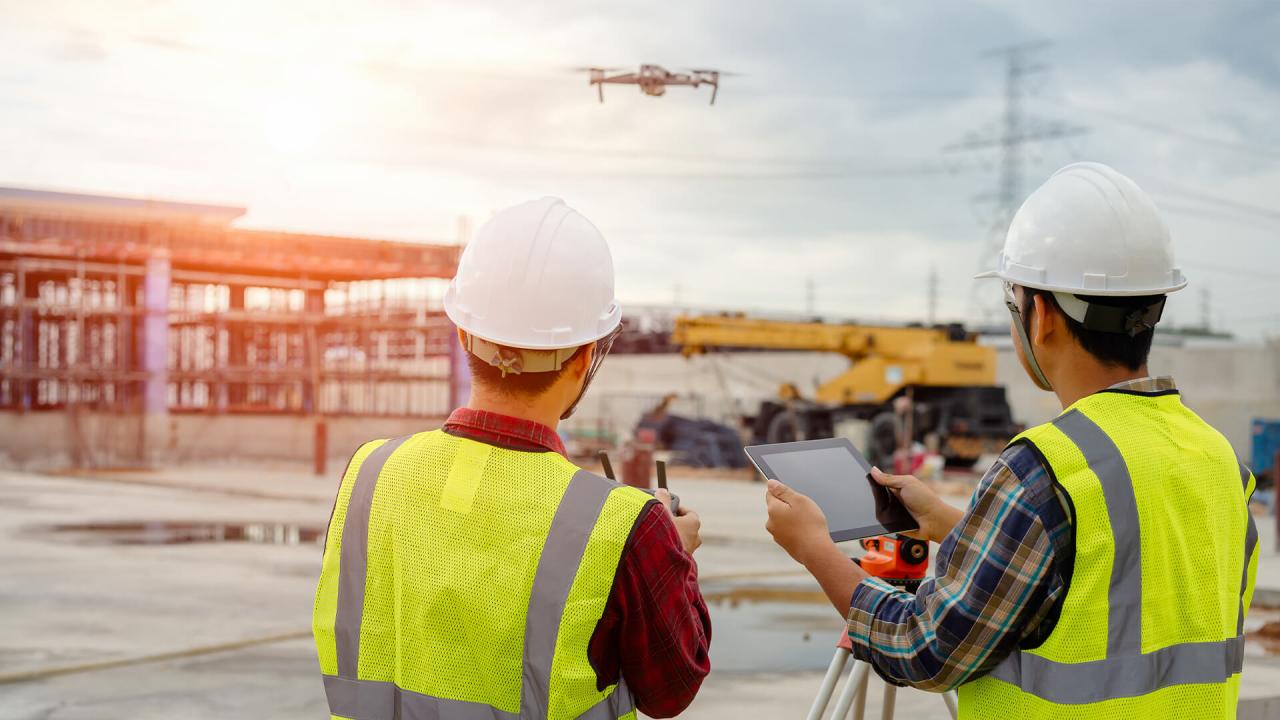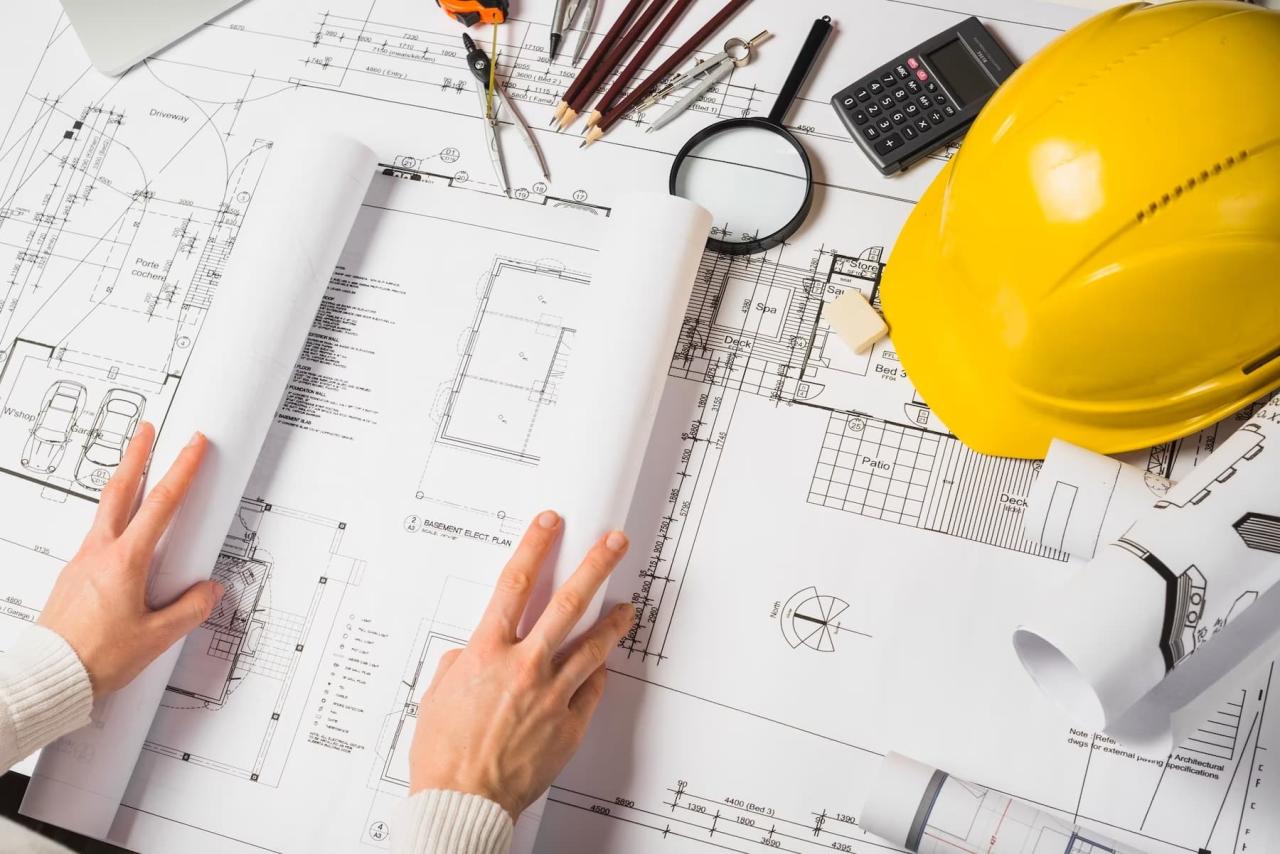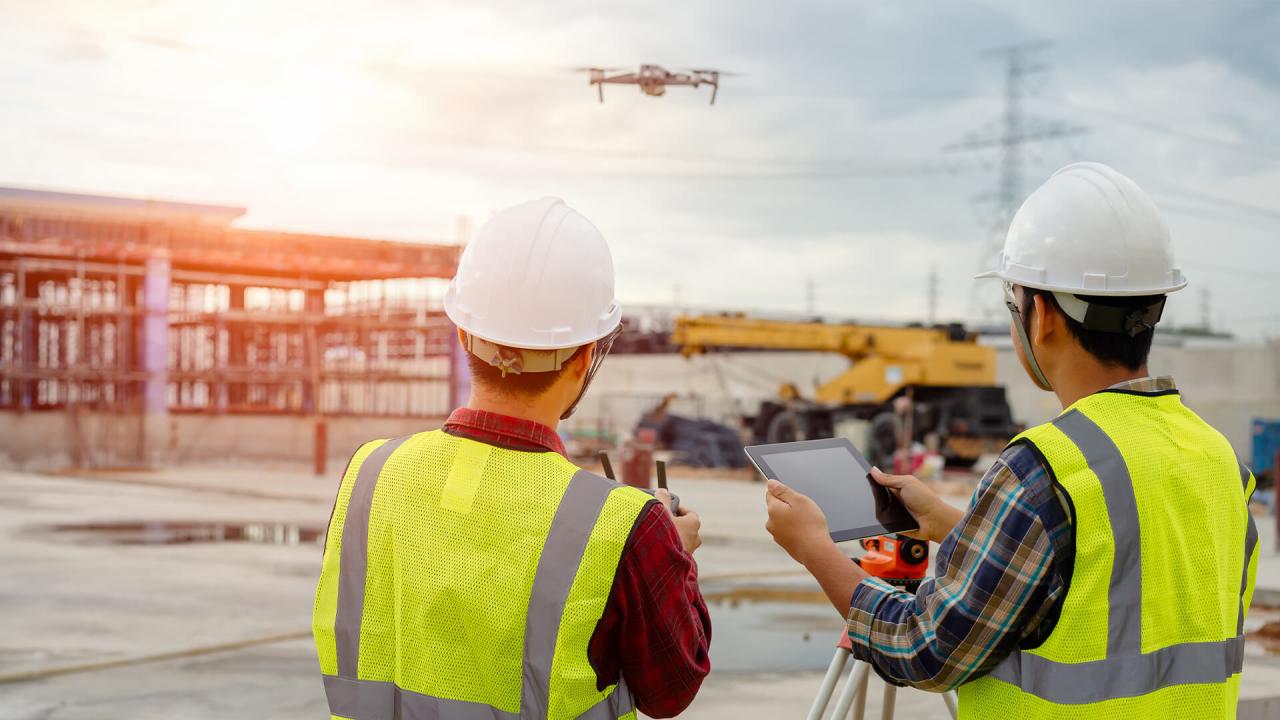Construction Technology Solutions: Building the Future
Construction technology solutions are revolutionizing the way we build, bringing efficiency, safety, and sustainability to the forefront. The industry is embracing innovative technologies to overcome challenges like labor shortages, project […]

Construction technology solutions are revolutionizing the way we build, bringing efficiency, safety, and sustainability to the forefront. The industry is embracing innovative technologies to overcome challenges like labor shortages, project delays, and quality control issues, leading to a more efficient and sustainable construction sector.
From Building Information Modeling (BIM) and project management software to drones and smart construction equipment, a wide range of technologies are transforming the construction landscape. These solutions are not only improving productivity and cost-effectiveness but also enhancing safety and minimizing environmental impact.
Benefits of Implementing Construction Technology Solutions
Construction technology solutions are revolutionizing the industry, offering numerous benefits that can significantly improve project outcomes and enhance overall efficiency. By embracing these advancements, construction companies can unlock a wealth of opportunities to optimize operations, reduce costs, and enhance safety.
Increased Productivity
The adoption of construction technology solutions can significantly enhance productivity by streamlining processes and automating tasks.
- Project Management Software: These platforms centralize project information, facilitate communication, and automate tasks such as scheduling, resource allocation, and progress tracking. This streamlined approach eliminates manual processes, reduces errors, and improves overall efficiency. For instance, a construction company using project management software might see a 20% reduction in project delays and a 15% increase in resource utilization.
- Building Information Modeling (BIM): BIM software allows for the creation and management of digital models of construction projects. This virtual representation enables stakeholders to collaborate effectively, identify potential issues early on, and optimize design and construction processes. Studies have shown that BIM adoption can lead to a 10-20% reduction in construction costs and a 15-30% improvement in project delivery time.
- Robotics and Automation: The use of robotics and automation in construction can significantly enhance productivity by automating repetitive and hazardous tasks. Robots can perform tasks such as bricklaying, welding, and demolition, freeing up human workers for more complex and skilled roles. For example, a construction company utilizing robotic bricklaying systems might achieve a 30% increase in bricklaying speed and a 10% reduction in labor costs.
Cost Reduction, Construction technology solutions
Construction technology solutions can contribute significantly to cost reduction by optimizing resource allocation, minimizing waste, and improving project efficiency.
- Cost Estimation and Bidding Software: These tools provide accurate cost estimates and help construction companies develop competitive bids. By leveraging data analytics and historical project information, these platforms ensure that bids are realistic and minimize the risk of overspending. A construction company using cost estimation software might achieve a 5% reduction in bid errors and a 10% increase in bid accuracy.
- Inventory Management Systems: These systems track inventory levels, monitor material usage, and optimize ordering processes. By minimizing waste and ensuring that the right materials are available at the right time, inventory management systems can reduce material costs and prevent delays. A construction company implementing an inventory management system might experience a 10% reduction in material waste and a 5% increase in material utilization.
- Construction Drones: Drones equipped with cameras and sensors can be used for site inspection, surveying, and progress monitoring. This technology reduces the need for manual inspections, saves time, and minimizes safety risks associated with accessing hazardous areas. For example, a construction company using drones for site inspection might achieve a 20% reduction in inspection time and a 10% decrease in inspection costs.
Enhanced Safety
Construction technology solutions play a crucial role in enhancing safety by providing real-time monitoring, identifying potential hazards, and automating safety procedures.
- Wearable Safety Devices: These devices monitor worker location, vital signs, and environmental conditions. They can alert supervisors to potential hazards, provide real-time assistance in emergencies, and ensure worker safety. For example, a construction company utilizing wearable safety devices might experience a 15% reduction in workplace accidents and a 10% decrease in safety-related downtime.
- Construction Site Monitoring Systems: These systems use cameras, sensors, and analytics to monitor construction site activity, identify potential hazards, and ensure compliance with safety regulations. By detecting unsafe practices and providing real-time alerts, these systems help prevent accidents and improve overall safety. A construction company using construction site monitoring systems might achieve a 20% reduction in safety violations and a 15% decrease in safety-related incidents.
- Virtual Reality (VR) Training: VR training simulations allow construction workers to practice safety procedures and emergency response in a safe and controlled environment. This technology enhances worker awareness of potential hazards and improves their ability to respond effectively in real-world situations. For example, a construction company using VR training simulations might see a 10% increase in worker safety knowledge and a 5% reduction in safety-related errors.
Minimized Environmental Impact
Construction technology solutions can help minimize the environmental impact of construction projects by optimizing resource usage, reducing waste, and promoting sustainable practices.
- Sustainable Building Materials: Technology enables the development and use of sustainable building materials, such as recycled concrete, bio-based materials, and energy-efficient insulation. These materials reduce the environmental footprint of construction projects and contribute to a more sustainable built environment. For example, a construction company using recycled concrete might achieve a 20% reduction in carbon emissions and a 10% decrease in material costs.
- Waste Management Systems: Construction technology solutions can optimize waste management processes by tracking waste generation, identifying recycling opportunities, and facilitating efficient waste disposal. This helps reduce landfill waste and promotes a more circular economy in the construction industry. For example, a construction company implementing a waste management system might achieve a 15% reduction in landfill waste and a 10% increase in recycling rates.
- Energy-Efficient Design and Construction: BIM and other design technologies enable architects and engineers to optimize building designs for energy efficiency. By integrating renewable energy sources, optimizing building orientation, and using energy-efficient materials, construction projects can minimize their energy consumption and reduce their environmental impact. For example, a construction company using energy-efficient design principles might achieve a 10% reduction in energy consumption and a 5% decrease in operating costs.
Types of Construction Technology Solutions
The construction industry has been rapidly adopting technology to enhance efficiency, productivity, and safety. Various technology solutions have emerged to address specific challenges and opportunities within the construction process. This section will delve into the different types of construction technology solutions, their descriptions, examples, and benefits.
Construction Technology Solutions
Construction technology solutions encompass a wide range of tools and applications that are transforming the industry. They can be categorized based on their functionalities and applications. The following table Artikels various construction technology solutions, their descriptions, examples, and benefits:
| Solution Category | Description | Examples | Benefits |
|---|---|---|---|
| Building Information Modeling (BIM) | A digital representation of a building project, encompassing its physical and functional characteristics. BIM provides a comprehensive and interactive model for planning, design, construction, and operation. | Revit, ArchiCAD, Tekla Structures | Improved collaboration, reduced errors, optimized design, enhanced visualization, and cost savings. |
| Project Management Software | Software applications designed to streamline project planning, scheduling, resource allocation, and communication. They facilitate efficient project management by providing tools for task management, progress tracking, and reporting. | Procore, Primavera P6, Microsoft Project | Enhanced project visibility, improved communication, streamlined workflows, and increased efficiency. |
| Construction Robotics and Automation | The use of robots and automated systems to perform repetitive or hazardous tasks on construction sites. This includes tasks such as bricklaying, welding, and concrete pouring. | Bricklaying robots, welding robots, autonomous excavators | Increased productivity, improved safety, reduced labor costs, and enhanced precision. |
| Virtual Reality (VR) and Augmented Reality (AR) | VR and AR technologies provide immersive experiences that allow users to visualize and interact with construction projects in a virtual environment. VR immerses users in a simulated environment, while AR overlays digital information onto the real world. | VR construction simulations, AR site visualization tools | Enhanced visualization, improved communication, reduced errors, and facilitated training. |
| Drones and Aerial Imaging | Drones equipped with cameras and sensors capture high-resolution aerial images and data, providing valuable insights for site surveying, progress monitoring, and safety inspections. | DJI Phantom 4, Inspire 2, Matrice 300 | Improved site surveying, enhanced progress monitoring, cost savings, and increased safety. |
| Smart Construction Equipment | Heavy equipment integrated with sensors, GPS, and data analytics to enhance efficiency, safety, and productivity. Smart equipment provides real-time data on performance, location, and maintenance needs. | Caterpillar’s Smart Iron, Komatsu’s Smart Construction | Increased efficiency, improved safety, reduced downtime, and enhanced data-driven decision-making. |
| Prefabrication and Modular Construction | Off-site construction methods where components or modules are prefabricated in factories and assembled on-site. Prefabrication reduces construction time, improves quality, and minimizes waste. | Modular homes, prefabricated building components | Reduced construction time, improved quality, minimized waste, and enhanced predictability. |
| Data Analytics and Artificial Intelligence (AI) | The use of data analytics and AI algorithms to extract insights from construction data, predict project outcomes, and optimize processes. AI can be applied for risk assessment, cost estimation, and scheduling optimization. | Predictive analytics software, AI-powered project management tools | Enhanced decision-making, improved risk management, optimized resource allocation, and increased efficiency. |
Case Studies of Successful Construction Technology Implementations

Construction technology solutions are not just theoretical concepts; they are being implemented in real-world projects with tangible results. Examining case studies of successful projects showcases the practical benefits and challenges of adopting these technologies. This section explores several noteworthy examples, highlighting the specific technologies used, the outcomes achieved, and the lessons learned.
Case Studies of Successful Construction Technology Implementations
These case studies demonstrate how technology is transforming the construction industry, driving efficiency, improving safety, and enhancing project outcomes. By learning from these examples, construction professionals can gain valuable insights into the potential of technology and identify best practices for successful implementation.
| Project Name | Technology Used | Key Outcomes | Lessons Learned |
|---|---|---|---|
| The Shard, London | Building Information Modeling (BIM), 3D Laser Scanning, Virtual Reality (VR) | Reduced construction time by 10%, improved communication and collaboration, minimized errors and rework, enhanced safety protocols. | Early adoption of BIM and VR is crucial for effective project planning and visualization. Strong leadership and training are essential for successful technology implementation. |
| Singapore Changi Airport Terminal 4 | Automated Guided Vehicles (AGVs), Robotic Arms, Drones for aerial surveying | Increased productivity by 20%, reduced labor costs, enhanced safety through automation, streamlined logistics and materials handling. | Careful planning and integration of automated systems are critical. Training and adaptation of workforce are essential for seamless operation. |
| San Francisco’s Salesforce Tower | Precast Concrete, Modular Construction, Advanced Robotics | Accelerated construction schedule by 25%, reduced on-site labor requirements, minimized waste generation, enhanced structural integrity. | Pre-fabrication and modular construction require meticulous planning and coordination. Integration of robotics requires specialized expertise and training. |
| The Panama Canal Expansion Project | GPS-guided earthmoving equipment, real-time monitoring systems, predictive maintenance software | Improved accuracy and efficiency of excavation and dredging operations, reduced downtime and maintenance costs, enhanced safety through real-time data analysis. | Technology adoption requires robust infrastructure and data management systems. Regular maintenance and software updates are essential for optimal performance. |
Final Thoughts
The future of construction is undoubtedly intertwined with technology. As we continue to see advancements in areas like the Internet of Things (IoT), blockchain, and 3D printing, the construction industry will become even more efficient, sustainable, and innovative. By embracing these technological advancements, we can build a brighter future for the construction sector.
Construction technology solutions are constantly evolving, aiming to streamline processes and enhance efficiency. Similar to the advancements in the automotive industry, where features like adaptive cruise control and lane departure warning are becoming increasingly common, the construction sector is embracing innovative technologies.
For instance, comparing the 2024 VW Atlas SE with Technology vs SEL reveals the significant impact of technology on vehicle functionality and safety. This same trend is evident in construction, where drones, 3D printing, and advanced software are transforming the way buildings are designed and built.










